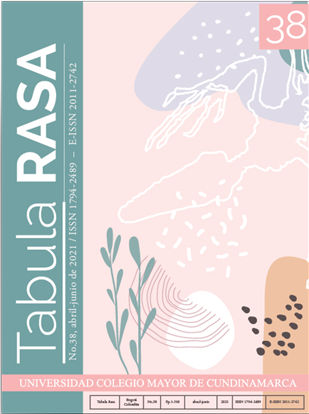Zapatista women reconceptualizing their struggle.
Las mujeres zapatistas reconceptualizan su lucha.
Show authors biography
Emerging gender reconfigurations in Zapatista women discourse are analyzed here. Those gender reexaminations stem from mobile complex processes revealing deeply rooted notions made up by historic, symbolic, and epistemic meanings of statements, such as: parityequality, gender fluidity-duality, benevolent destructive Mother Earth, «commanding by obeying», an authority enforcing community agreements, heart: the basis of knowledge and organization, intersubjectivity towards Earth, the environment, and a communal whole. Those are some paths of their own, rooted on ancestral Meso-American legacies reconfigured. The concept of otroas, compañeroas, niñoas, as an experience lived the present day is introduced, thus deepening the extent of some gender bipolarity, which confers it its inherent feature of ongoing change expressing the fluidity of gender.
Article visits 125 | PDF visits 86
Downloads
- Appfel, F. (2001). Andean Concepts of Nature. Presentation at International Conference on Orality, Gender and Indigenous Religions at Claremont School of Religion. Claremont California.
- Baez-Jorge, F. (1988). Los oficios de las diosas. Xalapa: Universidad Veracruzana.
- Burckhart, L. (1989). The Slippery Earth: Nahua Christian Moral Dialogue in Sixteenth Century Mexico. Tucson: University of Arizona Press.
- Ceceña, A. E. (1999). El Mundo del nosotros: entrevista con Carlos Lenkersdorf. Chiapas, 7, 191-205.
- Comandanta Esther. (2001). Queremos ser indígenas y mexicanos. En Perfil de la Jornada, IV, March 29, 2001. https://www.jornada.com.mx/2001/03/29/per-indigena.html
- Comandanta Ramona. (1999). Mensaje de Ramona. En Lovera, S. y Palomo, N., Las Alzadas, Segunda Edición, eds., pp. 302-303 (CIMAC-Convergencia Socialista, A.P.N.).
- Landa, D. de (1966). Relación de las cosas de Yucatán. México: Ediciones Porrúa.
- Olmos, A. de (1973). Teogonía e historia de los mexicanos. México: Editorial Porrúa.
- Sahagún, B. de (1989). Historia general de las cosas de la Nueva España. México: Consejo Nacional para la Cultura y las Artes.
- Casas, B. de las (1967). Apologética historia summaria de las gentes destas Indias. México: Instituto de Investigaciones Históricas, Universidad Nacional Autónoma de México.
- Furst, P. T. (1986). Human Biology and the Origin of the 260-Day Calendar: The Contribution of Leonhard Schultze Jena (1872—1955). En Gossen, G. H. (Ed.). Symbol and Meaning Beyond the Closed Community: Essays in Mesoamerican Ideas, Albany: Institute for Mesoamerican Studies, State University of New York.
- Gossen, G. & León Portilla, M. (1993). South and Mesoamerican Native Spirituality. New York: Crossroad.
- Gossen, G. H. (1986). Mesoamerican Ideas as a Foundation for Regional Synthesis. En Gossen, G.H. (Ed.). Symbol and Meaning Beyond the Closed Community: Essays in Mesoamerican Ideas. Albany: Institute for Mesoamerican Studies, State University of New York.
- Guiteras-Holmes, C. (1961). Perils of the Soul: The Worldview of a Tzotzil Indian. New York: Free Press of Glencoe.
- Gutierrez, E. (1993). The Christian Era of the Yucatec Maya. En G. Gossen & M. León Portilla. South and Mesoamerican Native Spirituality (pp.251-277). New York: Crossroad.
- Jiménez, C. (2003). Primera Cumbre de Mujeres Indígenas de América First Indigenous Women’s Summit of the Americas, Memoria (preparatory documents). México: Fundación Rigoberta Menchú.
- Karttunen, F. (1986). In Their Own Voices: Mesoamerican indigenous Women Then and Now. Suomen Antropologi: Journal of the Finnish Anthropological Society, 13(1), 2-11.
- Klor de Alva, J. (1988). Contar vidas: la autobiografía confesional y la reconstrucción del ser nahua. Arbor: ciencia, pensamiento y cultura, 515-516, 49-78.
- Lenkersdorf, C. (1996). Los hombres verdaderos. Voces y testimonios tojolabales. México: Siglo XXI.
- Marcos, S. (2011). Tomado de los labios: género y eros en Mesoamérica. Quito: Abya Yala.
- Marcos, S. (1998). Embodied Religious Thought: Gender Categories in Mesoamerica. Religion, 28(4), 371-382. https://doi.org/10.1006/reli.1998.0146
- Marcos, S. (1997). Mujeres indígenas: notas sobre un feminismo naciente. Cuadernos Feministas. 1(2), 14-16.
- Marcos, S. (1995). Sacred Earth: Mesoamerican Perspectives. Concilium, 5(261), 27-37.
- Morrison, K. M. (2000). The Cosmos as Intersubjective: Native American Other-thanHuman Persons. En G., Harvey (ed.). Indigenous Religions: A Companion, (pp.23-36). London-New York: Bloomsbury.
- Palomo, N. (1999). San Andrés Sacamchen. Si caminamos parejo, nuestros corazones estarán contentos. En S. Lovera & N. Palomo (Eds.). Las Alzadas, (pp. 456-459). Segunda ed., México: CIMAC/Convergencia Socialista, A.P.N.
- Smith, A. (1998). Report on the Native Health and Sovereignty Symposium. Report Editorial Board meeting Journal Feminist Studies in Religion JFSR.
- Subcomandante Marcos. (2001). La Cuarta Guerra Mundial. Ideas 1, Dic., p. 30. https://inmotionmagazine.com/auto/cuarta.html
- Thompson, E. (1975). Historia y religión de los mayas. México: Fondo de Cultura Económica.
- Vera, R. (marzo 27 de 2001). Autonomía no es independencia, es reconciliación. La Jornada, p.4.








